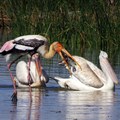Bird species are disappearing at an alarming rate in Kenya – new study

I was part of a team that carried out a study which assessed how changes to land use – including the expansion of settlements, livestock production, pest removal and cultivation – were affecting bird populations in the Lake Victoria Basin, in south-western Kenya.
We found that these changes degraded and destroyed natural landscapes at all three of our study sites. This caused a significant loss of bird biodiversity, including rare, threatened or unique species.
Comparing undisturbed and disturbed sites, diversity dropped from 71 bird species to just seven in Angurai, the most disturbed site. In Busia it dropped from 63 to 15 and in Lambwe Valley, the least disturbed site, it dropped from 32 to 22 species.
Our findings are particularly worrying because the African continent is home to 20% of the world’s bird species, totalling over 2,000 species. Of these 90% are endemics, found only in Africa. The rest are seasonal visitors, coming from parts of Europe, northern Asia, the Middle East and north Africa.
Our work highlights the urgent need to protect these habitats from increasing agricultural and developmental pressures.
The study
We compared bird species richness, diversity and composition at three sites in the Lake Victoria Basin in western Kenya, following the removal of a pest – the tsetse fly – and subsequent changes to the land. Tsetse flies, found in most parts of Africa, are one of the main reasons why land isn’t converted to agriculture. They carry diseases that are fatal to both people and animals. So eradicating them, typically using chemicals, is the first step before agriculture or development can happen.
At each of the three sites, there were natural and disturbed landscapes which we used for comparison. In the Lambwe Valley site, for instance, we compared transects within the Ruma national park with others in adjacent human settlement areas.
Birds were detected, identified and counted by sight or their calls. To ensure consistency and minimise observer biases, the same observer and recorder did all the surveys at each site.
A total of 168 different bird species were detected. In Busia and Angurai, there were 68 and 61 species respectively. In Lambwe valley, there were 53. Some species were detected in both the disturbed and natural areas at each site.
Impact of land use change
Land use changes had several adverse effects on bird habitats and species richness.
First, land use changes altered the size and quality of habitats.
Conversion to cultivation and natural cover removal meant the remaining vegetation wasn’t enough to support certain bird species, like woodland savanna birds, with the resources they needed to survive.
Natural vegetation, including fruit trees, was sometimes replaced by invasive plants. This also led to the loss of food (seeds or insects) for certain bird species.
In some areas, an increase in invasive plants favoured opportunistic and generalist bird species, as opposed to bird species that rely on native plants and specific habitat conditions.
Second, bird species richness and diversity decreased strikingly in disturbed areas compared to natural ones.
Disturbed areas had far fewer feeding guilds – groups of bird species that share similar feeding behaviours and food resources. For instance in Angurai’s altered site, there were only seven species in disturbed areas compared to 66 in natural areas.
Third, some specialised feeding guilds, like insect or grain feeders, were found exclusively in natural habitats, indicating they’re more susceptible to habitat disturbances. Their food is abundant only in natural habitats.
Fourth, habitat changes don’t affect all birds in the same way. Some species can exploit disturbed habitats while others are more sensitive to changes. For instance, though their overall diversity decreased, estrildid finches were more prevalent in disturbed landscapes.
Non-migratory bird species showed adaptability or resilience to human-altered landscapes, but faced greater risks – such as reduced food availability, increased predation, and loss of nesting sites – as their habitats degraded.
Migratory bird species generally avoided disturbed areas, preferring natural habitats.
Specialised species, like ground-foraging birds, were more affected in disturbed landscapes.
Ultimately, high-quality, larger habitats are crucial for maintaining bird species diversity. Degraded and smaller habitats tend to support lower diversity.
Conservation efforts
Given the magnitude and pace of the land conversions, urgent steps are needed to slow down, stop or reverse biodiversity loss.
We suggest the following:
- Land-use planning in sub-Saharan Africa needs to incorporate conservation principles that maintain essential habitat qualities – like food resources, space, shelter and connectivity – needed by various bird species.
- It is crucial to preserve pristine habitats and restore degraded ones. This can be done, for example, through payment for ecosystem services. For example, in Mexico a programme compensates landowners who maintain and restore ecosystems on their property. This provides an incentive for conservation while allowing sustainable agricultural practices.
- More needs to be done to monitor changes in bird species richness and diversity. This will help to inform interventions and flag which species are at risk and need enhanced protection.
- It is crucial to expand and support protected areas as much as possible. This requires adopting strategies to balance agricultural development and the expansion of protected areas. For instance Costa Rica has successfully increased its forest cover through strategic zoning and sustainable agricultural practices. Another approach is using agroforestry. In Kenya’s western highlands, practices combining tree planting with agricultural crops have helped conserve biodiversity while boosting agricultural productivity.
Achieving these objectives will likely be extremely difficult due to the surging human population in sub-Saharan Africa, which intensifies competition for limited resources.
It is therefore necessary to focus on present and future development efforts that promote more intensive agriculture as opposed to extensive land clearing for cultivation and boost productivity within existing farming systems to promote environmental sustainability.![]()
This article is republished from The Conversation under a Creative Commons license. Read the original article.
Source: The Conversation Africa

The Conversation Africa is an independent source of news and views from the academic and research community. Its aim is to promote better understanding of current affairs and complex issues, and allow for a better quality of public discourse and conversation.
Go to: https://theconversation.com/africaAbout Joseph Ogutu
Joseph Ogutu, Senior Researcher and Statistician, University of HohenheimRelated
Saving the bees: How Nedbank and WWF are working to ensure honeybee survival 12 Nov 2024 2024 Earthshot Prize - the 5 winners of £1m 7 Nov 2024 Madagascar’s mining rush has caused no more deforestation than farming – new study 8 Oct 2024 Africa’s famous Serengeti and Maasai Mara are being hit by climate change – a major threat to wildlife and tourism 4 Oct 2024 Plan for reshaping conservation revealed 30 Sep 2024 Exploring SanParks’ 30-year eco-tourism and commercialisation journey 22 May 2024 Minister’s plan could wipe out African penguins, say scientists 25 Mar 2024 De Berg Nature Reserve declared 30th Ramsar site 2 Feb 2024




